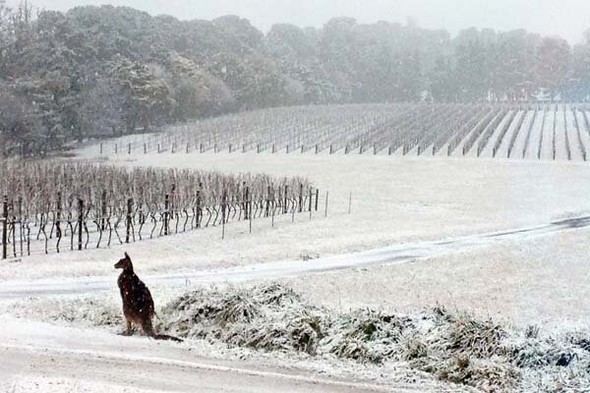The opening image of the kangaroo in the vineyard in a snowstorm is from here (K&L Wine Merchants)
In case, it’s not yet clear. I will tell you now. In my sarcastic introduction, I tried to suggest that most consumers, and even most winemakers, don’t know what a cool climate is, or if they do, they use the term incorrectly. I am being benign, perhaps not on purpose.
The basic thesis is that there are two types of wine regions in the world, warm and cold climate. This is an inevitable simplification. Have you ever tasted a fresh, crisp Catarratto wine from Sicily, from the side of Etna? Did you find it strange that it has cool acidity, elegance and moderate alcohol? The key is right there in the altitude, as well as the winemaking technology. Or there is Minis in Romania, which strictly speaking is located in a cool climate region, or Villány in Hungary. Yet, due to the microclimatic conditions in these places, the climate is much more sub-Mediterranean, so these regions produce fuller-bodied, riper wines with high alcohol levels, such as Tamás Lelovits’s Meglepetés Kékfrankos, or Géza Balla’s Kadarkas. However, a simple glance at a ‘climate zone’ map should show the opposite!
Let’s look at some stereotypes about wine. The average consumer expects warm climate wines to be mostly red, with dense tannins, jammy flavours, low acidity and high alcohol, while a cool climate wine is the opposite. Be it red or white, it is always fresh and vibrant with crisp acidity and lower alcohol. However, it is worth approaching the issues with caution. Ask yourself, or if you don’t know, as a winemaker a few questions. Is it not possible to produce a wine with a cool character in a warm region? Does it not depend on the grape variety, the harvest date, the cultivation method, the winemaking technology and the ageing? The situation is different in cooler climates, where it is more difficult to make wines with a ‘warm character’ in truly cool climate regions, where microclimatic conditions come into play. Eger is perhaps the best example of this in Central and Eastern Europe. This town, famous for its wine production since the Middle Ages, has always had been known for its warm vineyards, some of which have been known for years as the ‘Africa vineyards’, simply because they are always the warmest. In such cases, winemakers may choose to plant varieties that will not ripen elsewhere, such as Cabernet Sauvignon, but it the varietal character will ultimately be a cool climate CabSav, or you can plant a native variety, say a Kékfrankos, which will give a very warm character. However, most of the region’s vineyards are classic cool climate vineyards, so the wines are typically elegant, lean and fresh, even in the case of top wines, like the Böjt Bikavérs.
What seems certain, however, is that climate change will increase the value of cool climate areas. This may mean that vineyards will climate higher up the hillsides in Sicily, while vines are starting to be planted on the north-eastern slopes in Tokaj, but the trend is also illustrated by the fact that more than a hundred wineries have been established in Poland – not exactly a wine country – in the last decade. Of course, this is also reflected in the dramatic improvement in the quality of English sparkling wines and the new grape varieties authorised in the Bordeaux AOC, such as Tempranillo. Either way, we have to respond to climate change…






